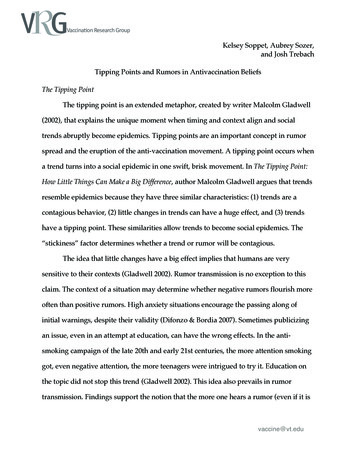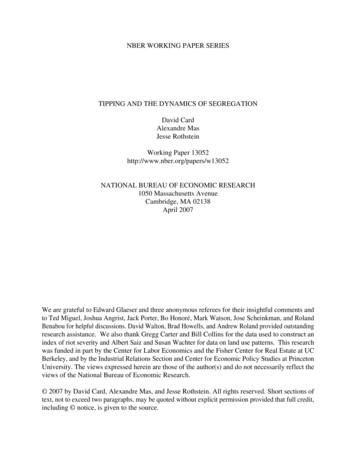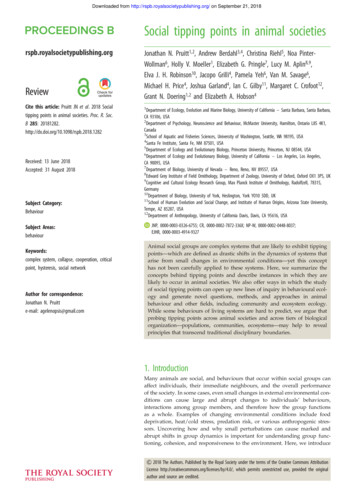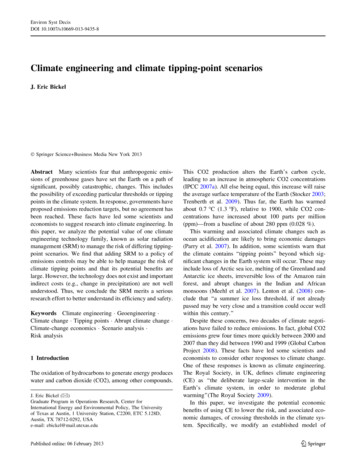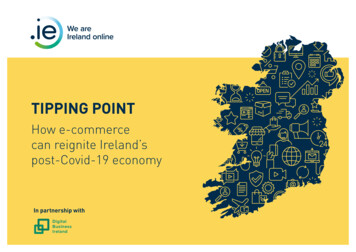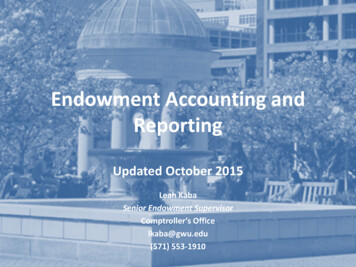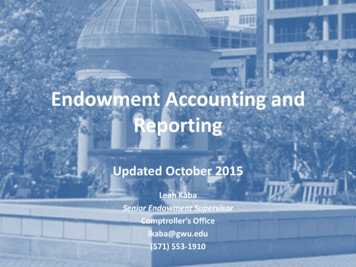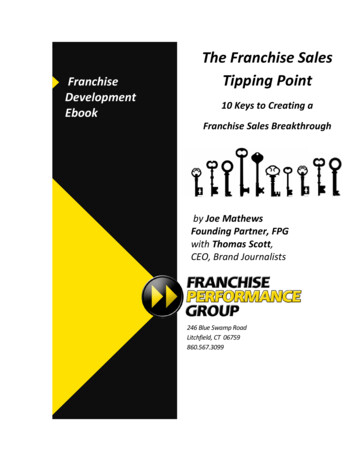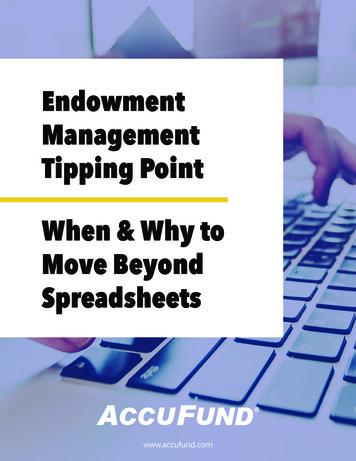
Transcription
EndowmentManagementTipping PointWhen & Why toMove BeyondSpreadsheetswww.accufund.com
Endowment Management Tipping PointPage 2IntroductionIn Malcolm Gladwell’s book, The Tipping Point, he explainshow small actions at a specific time, in a specific place,and with certain people can create a “tipping point” foranything, be it a product, idea or trend.Does it apply to endowment management? If you’remanaging your endowments by spreadsheets, it sure does.What is your tipping point when it comes to managingendowments? What tasks do you do, day in and day out,that could or should be automated? Do you have enoughpeople knowledgeable in the systems and proceduresof endowment management? Are manual processesoverwhelming? Have you reached the point where you say,“enough is enough, there has to be a better way?”In this executive paper, we’re highlighting sevenEndowment Management Tipping Points. What is yourtipping point? And what can you do to bring about change?
Endowment Management Tipping PointPage 3Tipping Point #1You Realize there are Gaps in your Communication.Communication, in all forms, is critical. You work with people—your community members, your co-workers,your board of directors, your donors. The ability to share ideas, discuss options, make decisions, planstrategically—all require some form of communication.Think about the data and reports you need and how easily you can produce them. Can they be run (evenscheduled) directly from the financial management system? How easily can they be shared electronically? Tosupport your finance committee and board of directors, how easily can you produce the Statement of FinancialPosition or Statement of Activities? There’s nothing automatic about reporting from a spreadsheet.Communicating relevant data with key decision-makers is critical to organizational success. The same is truefor your donors; you want to be able to make it easy for them to track and monitor their support—with accessto endowment statements on the fly and/or website access to endowment records.What gaps are in your communication? Is it a matter or not having access to the information at all or is it amatter or not having timely, real-time access to the information?Communicating organizational data keeps everyone informed, working towards the same common goal. If youare managing endowment records in a spreadsheet, it’s impossible to share the full story of your organizationwith donors, co-workers and your community. It slows down the exchange of data to all parties involved.Warning Signsn You can’t schedule reportsn You don’t have dashboards by user, perrole in organizationn You can’t drill down into underlying detailn You can’t provide statements to donorsn Annual audits are stressful
Endowment Management Tipping PointPage 4Tipping Point #2Compliance to Accounting Standards is Challenging.Compliance is required. The first line of thestandard audit letter reads, “We have audited thefinancial statements of ”. Can your system easilyproduce the financial statements needed? Can youprovide a trial balance or general ledger reportsyour auditors request? Do you have an audit trailfor transactions?If your system can provide financial statements,can it comply with the new ASU 2016 accountingstandards? Can it automatically keep track of thestatus of restricted and unrestricted funds?Does your system or spreadsheet provide thetime-tested security of double entry bookkeeping?Spreadsheets cannot provide this basicmethodology and do not comply with acceptedaccounting standards.And there’s more.Another important part of compliance is the abilityto audit calculations and procedures, such asinvestment return allocations. It’s important to havesystems that can document the history of howcalculations are derived and provide the ability toview prior methodology. Many systems, includingspreadsheets, only give the record according tocurrent balances, but fail to keep the records ofwhat the balance was a few months ago when thecalculation was made.Endowment management is complicated, buthaving software designed for the task can make allthe difference. Being able to shine during an auditand having confidence that your records are GAAPcompliant will go a long way to helping you garnerfuture funds for your organization.
Endowment Management Tipping PointPage 5Tipping Point #3Difficulty with Best Practices—UPMIFA Compliance.Prudent management and compliance of UPMIFA (Uniform Prudent Management of Institutional Funds Act)standards must be observed, especially in today’s challenging environment.Automating compliance with these guidelines is difficult with a spreadsheet or systems that are not meant forendowment management. Observing spending rules and guidelines can be complicated and error prone andoftentimes administrators can quickly become overwhelmed.The ability to grow endowmentsand aggressively seek newendowments is oftentimeshampered by inadequatesystems. For example, it’simportant to be able to handlenuanced spending policies thattake a weighted approach toprotecting the finances of theendowment and smooth out theeffects of market fluctuations.Another best practice is unitizingEndowment Funds, especiallywhen endowment funds maybe diversified among more thanone investment pool. Creating asystem for unitizing all donationsrequires a system that has thatspecific capability. Trying tocreate and maintain units in aspreadsheet is a daunting andperhaps dangerous task.An endowment accountingsystem that can automatecalculations can add a capacityfor growth and confidence toa management team that bestpractices are being observed.
Endowment Management Tipping PointPage 6Tipping Point #4You Question the Security of your Organization’sEndowment Data.In today’s savvy technological environment, keeping data secure is getting more complicated than ever.It’s seemingly a daily occurrence hearing about a cyber-attack, be it large corporations, small businesses,governments, or individuals. How confident are you in the security of your data?You know what’s coming: if you’re managing endowments in spreadsheets, unfortunately, they are not secure.Spreadsheets are susceptible to external threats such as blunt force attack and while often left open, at whichpoint the data is open, can be copied or used for other purposes.Beyond external threats, there are several internal security weaknesses of using spreadsheets when managingendowments.n Lack of Role-Based Security. Perhaps certain staff members should not see allendowment data. That’s hard to do with a spreadsheet.n Spreadsheets Prohibit Segregation of Duties and Proper Audit Trail.Perhaps a fund manager wants to limit an employee to certain tasks, suchas entering in contributions, while delegating interest distributions to anotheremployee. Enforcing this type of scenario is not possible in many systems anddefinitely not spreadsheets.n Accuracy of Spreadsheet Data. Sometimes when there are multiple users of aspreadsheet, one can be working in a conflicted version because a spreadsheetdoes not have the capacity to manage multiple file record access.n Spreadsheets Lack Historical Record. Changes to data are not recorded,whereas a proper endowment system should track the user, date, and time achange or addition to data is made.Ensuring your endowment data is secure is critical. Donors trust endowments to be discreet with information.It is critical to have systems in place that ensure data remains confidential.
Endowment Management Tipping PointTipping Point #5You Realize Consistency Over Time is Needed.Everyone has their preferred systems and procedures for doing things. In managing endowments, if youare using spreadsheets, you’re relying on the interpretation of the user who created the spreadsheet.Over time, employees move on or transition in and out of different roles, and oftentimes key understandingcan be lost in translation.Not everyone has the same skillset in Excel. An employee that doesn’t understand links and formulas thatwere created by a savvy Excel employee, could easily break how the spreadsheet works. The time andenergy required to find and repair that error can be an enormous issue.Managing organizational growth while relying on spreadsheets for reporting can really put you in a box,unable to adapt to meet the new reporting and transparency requirements of your organization.Having an intuitive endowment management system takes the guesswork out of trying to understand andwork with spreadsheets and puts you in position for growth and success.Page 7
Endowment Management Tipping PointPage 8Tipping Point #6Volume of Manual Data Entry is Error-Prone.Fraudulent manipulations in company spreadsheets can result in damaging losses. It’s challenging to enforceinternal controls to catch these occurrences. While fraud will always be a threat to spreadsheet systems, theyare also susceptible to seemingly trivial human error.Inadvertent missed negative signs and misaligned rows may sound harmless, but when they damage donorconfidence or cause a considerable loss of opportunity, it can be catastrophic.A strong endowment system will provide automations for accounting transactions and will immediately reduceerrors. Additionally, reconciliation functions can tie the investment accounts to the endowment records.Managing endowments with spreadsheets raises a red flag in these areas:n No double entry accounting therefore no tie-in to the balance sheet.n Time consuming—manually posting to an Excel spreadsheet becomes exponentially time consuming asyour endowment grows.n Difficult to have data automatically post into spreadsheets from other sources.n No audit trail tracking who entered data and when.n There is no automation of tasks to ensure that data is entered correctly and consistently every time.n Spreadsheets do not log transactions and do not allow supporting documents to be attached to atransaction.n Allocating investment returns is error-prone.n No reconciliation functions to ensure correctness of data.One of the most common tipping points for switching to a specific endowmentaccounting system (that we’ve witnessed) is using spreadsheets to track transactionsand allocate returns is error-prone.
Endowment Management Tipping PointPage 9Tipping Point #7You are at Organizational Capacity—AnticipatedGrowth is Stressful.Growth is good. It likely means you’re servicing more community members, increasing your offerings, improvingyour fundraising, managing more grants, and growing your endowment.If you’re managing with spreadsheets, as organizational growth increases, the amount of effort required tomaintain spreadsheets grows exponentially. And this increased use of time and resources will limit the ability ofyour endowment to grow.A spreadsheet lacks multi-dimensional capacity; meaning multiple systems must be maintained to trackendowment data. For example, details about a new fund, such as purpose, restrictions, donor intent, etc. aredifficult to store in a spreadsheet, and require separate files for such data.Similarly, documents related to an endowment would need to be stored separately from the spreadsheet ratherthan as a part of the endowment system. When the tools you use to manage endowments don’t have a clearpath to growth, it becomes counterproductive.Managing by Spreadsheetsn Limits organizational capacity.n Limits data that can be tracked on each fund.n Does not provide for document managementrelated to individual funds and transactions.
Endowment Management Tipping PointPage 10About AccuFundEndowment SystemThe AccuFund Endowment System was developed specifically for endowments and foundations.As a result of increased and changing demands, endowments require a system that automatesprocesses and ensures accuracy. Built on a robust accounting platform, the AccuFund EndowmentSystem ensures reliable data with a strong audit trail.The AccuFund Endowment System can handle the demands of any-sized endowment.More than just an accounting system, the AccuFund Endowment System can help staff efficiently,actively manage funds by providing tools that can help monitor deadlines, distribute reports,provide dashboards, and manage documents.Should your system need to do the day-to-day accounting for your endowment, or even otherdepartments of your college/university/nonprofit, simply pick and choose from AccuFund’s regularaccounting modules, such as accounts payable, purchase orders, accounts receivable, and manymore.AccuFund offers onsite or online deployment options:n Onsite. The traditional method of housing your software. License a solution that isinstalled on a server that resides physically within your organization.n Online. True browser-based solution. Subscription-based. Pay a monthlysubscription fee to access the solution through a browser.For more information please contact us at 877-872-2228 x215or email us at sales@accufund.com.Visit our website www.accufund.com for more product information, a schedule ofendowment webinars, and other information on fund accounting solutions.
Endowment Management Tipping Point Page 3 Tipping Point #1 You Realize there are Gaps in your Communication. Communication, in all forms, is critical. You work with people—your community members, your co-workers, your board of directors, your donors. The ability to share ideas, discuss options, make decisions, plan
